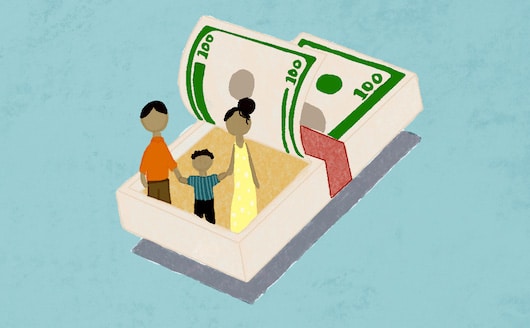A new study out of Georgia found that the monthly Child Tax Credit payments made to families during 2021 resulted in fewer children visiting the emergency room with abuse- and neglect-related injuries. It is the first study to directly analyze the effect these temporary payments had on child abuse and neglect.
The findings suggest that even “modest” income support for families by the federal government can have a protective influence on children, authors Lindsay Bullinger and Angela Boy of Georgia Tech’s School of Public Policy wrote in the study. And it builds upon prior research that has shown boosts to material resources can significantly decrease the prevalence of child maltreatment.
“This research adds to the evidence showing that income-support public policies such as the child tax credit expansion, more generous tax credits, and minimum wage increases support parents in keeping their kids safe and secure,” Bullinger stated in a press release. “This is important research for policymakers, child advocates — really anyone who is committed to keeping kids healthy and safe.”

Illustration by Christine Ongjoco
The study, published in JAMA Network Open, examined abuse- and neglect-related visits to the emergency department in three Georgia hospitals in the four days following the disbursement of a child tax credit payment. Researchers compared those totals to visits made in the same timeframe in years prior, and to visits made in the days leading up to payments.
In the four days after monthly payments were made, such visits temporarily decreased by 22% compared to the two weeks prior, and were lower than the same time period in prior years.
The researchers found, though, that the decrease in abuse and neglect emergency room visits only lasted for those four days following the payment. After that point, they bounced back to levels seen in the days before the payment.
But the study also found that the reductions increased during the second half of the six-month program, suggesting the possibility of a cumulative effect.
The temporary monthly payments were the result of enhancements made to the Child Tax Credit (CTC) as part of the COVID-era American Rescue Plan Act. Aimed at stabilizing families through a rocky economic period, the credit was raised from $2,000 per child to up to $3,600 and was expanded to include 17-year-olds. It also provided monthly payments in advance of tax season, as opposed to paying out one lump sum with tax returns, providing between $250 and $300 per month, depending on the child’s age.
The funds reached the families of nearly 62 million children from July to December 2021, according to IRS data. Studies of the credit have shown that the funds were used to cover basic household expenses like housing, food and child care, and that they reduced food insecurity and financial hardship.
“Because experiencing material hardship is associated with child maltreatment, we expect these CTC payments to also be associated with child abuse and neglect in the short run by potentially reducing material hardship, reducing parental stress, and improving family functioning,” Bullinger and Boy write in their report, which was funded through a grant from the Doris Duke Charitable Foundation administered through the Urban Institute.
Bullinger called on lawmakers to consider the impact of providing material support to families when crafting policies to promote child safety and wellbeing.
“Child abuse and neglect is very costly, both to individual children and families, and also to society,” Bullinger stated in a press release. “If we can reduce exposure to this adverse experience with small improvements to policies here and there, the benefits are likely large in the long run.”


